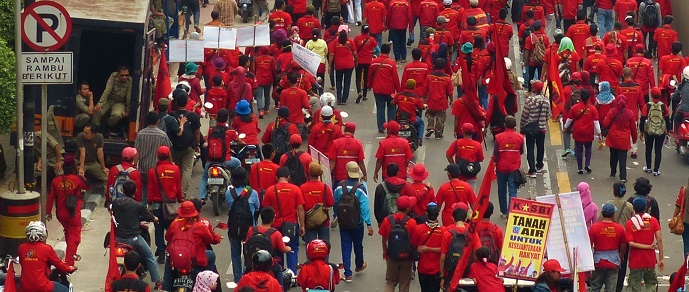Poverty Rate Indonesia: 11.1% of Population in September 2015
On Monday (04/01) Indonesia's Statistics Agency (BPS) announced that the number of Indonesian people living below the poverty line stood at 28.51 million people in September 2015, or 11.13 percent of the total Indonesian population. Compared to March 2015 the number of Indonesians living below the poverty line fell by 80,000 people. However, compared to September 2014 the number rose by 78,000 people. BPS releases poverty figures twice per year covering the months March and September.
BPS Head Suryamin said poverty in Indonesia has risen on a year-on-year basis due to higher fuel and food prices (particularly the higher rice price is a problem as the poorer segments of Indonesian society spend a relatively large chunk of their disposable income on rice). Another important factor is Indonesia's economic slowdown. Since 2011 the country's economic growth has been in a slowdown-mode due to sluggish global growth and low commodity prices. Indonesia is a major commodity exporter, implying that this sector provides employment and income to many Indonesian workers. As such, turmoil in the agriculture and mining sectors have a direct impact on Indonesia's poverty and employment figures.
In Indonesia a large portion of the population lives just above the poverty line and therefore volatile food prices, high inflation or higher fuel prices can quickly push these people below the poverty line, thus causing a higher poverty rate.
Currently, Indonesia's poverty line is set at a monthly income of IDR 344,809 (USD $24.8), up from IDR 312,328 per capita in September 2014.

A characteristic of Indonesia is that poverty is highest in the western part of the country in terms of absolute poverty. Per September 2015 there were 15.31 million poor people living on Java (Indonesia's most populous island), and 6.31 million on Sumatra. However, in terms of relative poverty, it is the eastern part of the country that shows high poverty. The Moluccas and Papua have a relative poverty rate of 22.09 percent of the local population. This distinction between absolute/relative poverty in the western and eastern parts of the country has been there throughout history. Since pre-colonial days the western part of Indonesia has been situated closer to the (global) trade routes (particularly the Strait of Malacca), while the eastern part is located in a more-or-less economic vacuum. Therefore, the western part of Indonesia is the more developed part.
Read Analysis: Poverty in Indonesia
Poverty in the rural areas of Indonesia is higher than in the urban areas. Based on the latest data from BPS, the urban poverty rate stood at 10.62 million (absolute) and 8.22 percent (relative), while the rural poverty rate stood at 17.89 million (absolute) and 14.09 percent (relative) in September 2015.
Indonesia's Poverty Statistics:
| 2007 | 2008 | 2009 | 2010 | 2011 | 2012 | 2013 | 2014 | 2015 | |
| Relative Poverty (% of population) |
16.6 | 15.4 | 14.2 | 13.3 | 12.5 | 11.7 | 11.5 | 11.0 | 11.1 |
| Absolute Poverty (in millions) |
37 | 35 | 33 | 31 | 30 | 29 | 29 | 27.7 | 28.5 |
Source: Statistics Indonesia (BPS)
